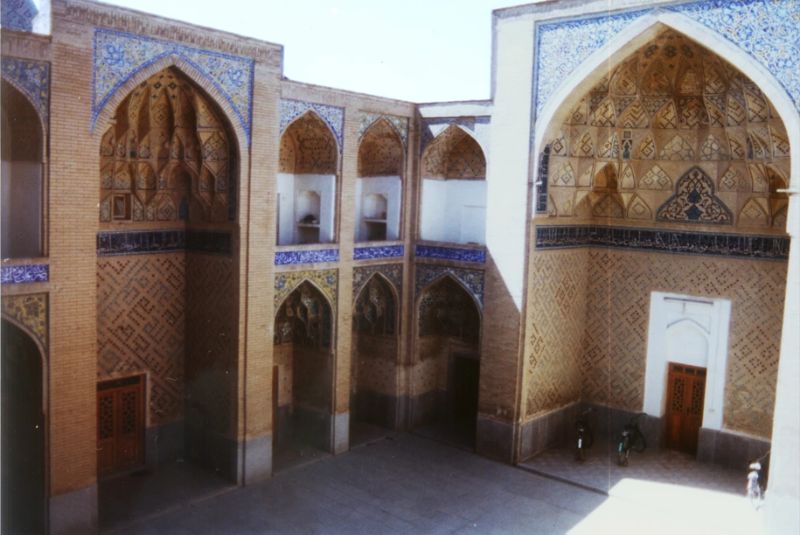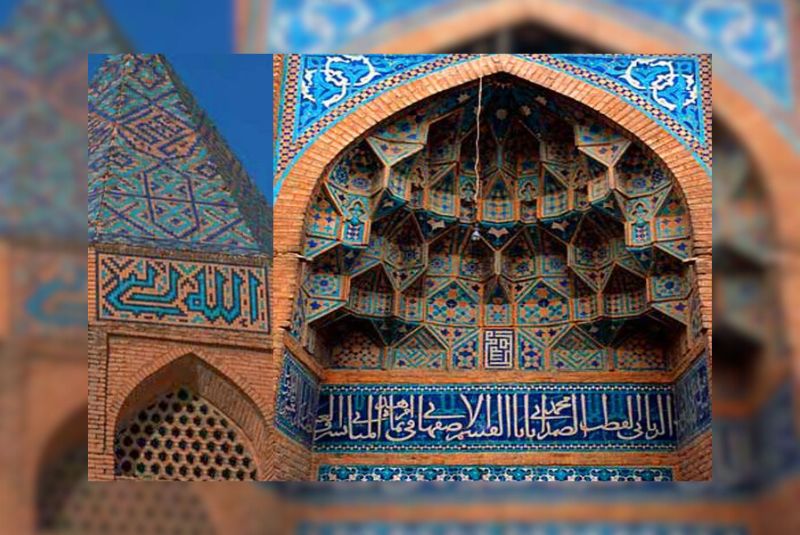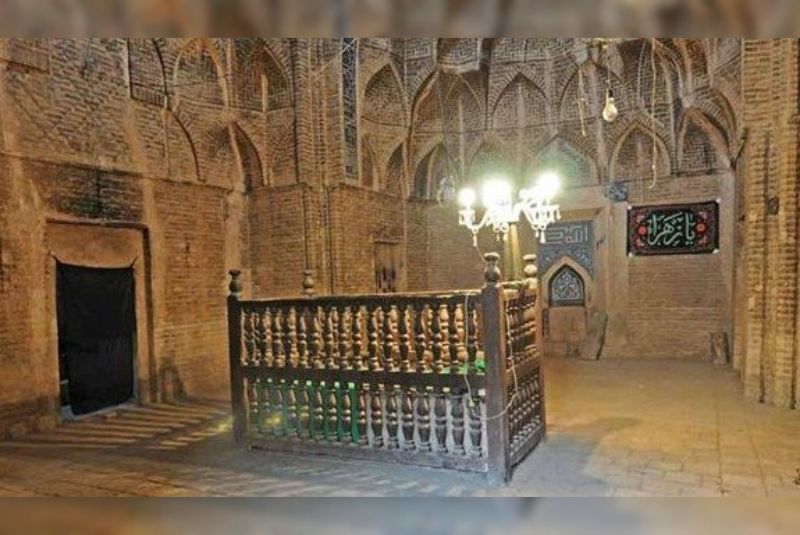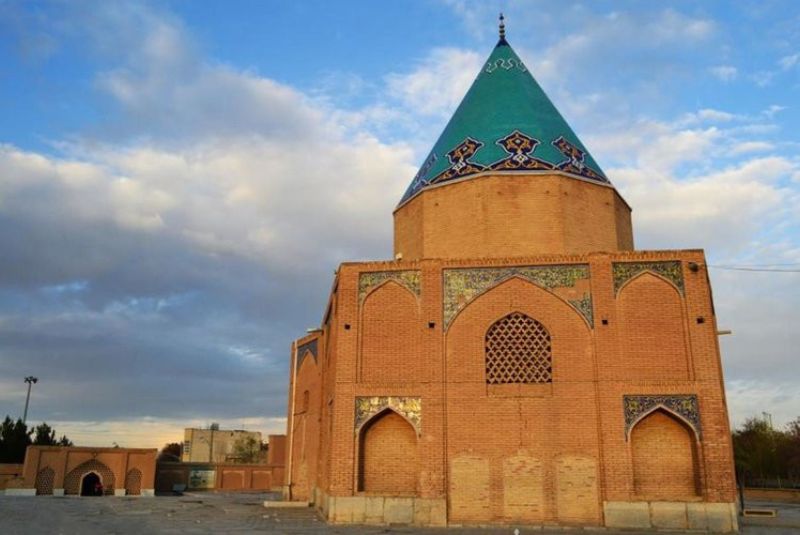Baba Ghassem Mosque: Isfahan's Iconic 14th-Century Site
Baba Ghassem Mosque, also known as Baba Ghassem Mausoleum, is a significant historical site located in the historic Ibn Sina neighborhood of Isfahan, Iran.
Dating back to the 14th century during the Ilkhanid era, this mosque is a remarkable example of Persian architecture and holds an esteemed place in the city’s cultural heritage.
The mosque is particularly noted for its beautiful minaret and the pyramid-shaped dome that crowns the structure, creating a visually striking landmark. It is also listed on the list of Iranian national monuments.
Inside the mosque, visitors find the tomb of Baba Ghassem, a revered cleric from Isfahan, alongside another tomb of an unknown figure. The interior is simple yet elegant, featuring walls adorned with intricate Thuluth calligraphy and vibrant faience tiles.
This combination of architectural beauty and historical significance makes the Baba Qasim Mosque a serene place for reflection and a vital part of Isfahan’s spiritual landscape.
In addition to its religious importance, the mosque was restored during the Safavid era, further emphasizing its historical value. The respect and reverence once held for this mausoleum were so profound that people would swear by it to prove their honesty. This blog will explore the rich history, architecture, and cultural significance of Baba Ghassem Mosque.
About Baba Ghassem Mausoleum

The Baba Ghassem Mausoleum, located in the Ebn-e Sina district of Isfahan, is a significant historical and religious monument dating back to the 14th century during the Ilkhanid period.
This revered site was registered on Iran's national monuments list on January 5, 1932 and was built by Sultan Abi al-Hassan Talut Damghani, a devoted student of Baba Ghassem. The mausoleum features a stunning mihrab, a beautiful dome, and intricate brick and tile decorations, including the names of Allah inscribed in Bannai script.
Baba Ghassem was a prominent cleric and mystic in Isfahan, respected deeply by the locals. Baba Ghassem tomb is housed in a mausoleum with a semi-circular dome resting on a square base, transitioning into an octagonal form with intricate muqarnas (stalactite-like decorations).
The mausoleum was later restored during the Safavid era, further enhancing its architectural beauty and preserving its historical significance. This sacred site continues to be a place of reverence and reflection for visitors.
Baba Ghassem Mausoleum History

Baba Ghassem, also known as Baba Qasim al-Isfahani, was a revered Sufi mystic and religious teacher in 14th-century Isfahan. Renowned for his piety and spirituality, he was deeply respected by the people of Isfahan and surrounding regions.
He taught Islamic and mystical knowledge at a madrasah in the Toghchi neighborhood of Isfahan, significantly influencing the spiritual and intellectual life of the city.
Following his death, Baba Ghassem was buried near the madrasah where he had taught. In 1340-1341, one of his devoted students, Sulayman ibn Abu'l Husayn ibn Talut al-Damghani, constructed a mausoleum over his grave, featuring a distinctive conical dome.
This mausoleum, located in the Shahshahan neighborhood of Isfahan, became a place for people to honor Baba Ghassem’s legacy and teachings. The mausoleum was later renovated during the reign of Safavid ruler Shah Safi, further enhancing its architectural beauty.
Today, the Baba Ghassem Mausoleum stands as a significant spiritual site and a remarkable example of Ilkhanid architecture, reflecting the enduring impact of Baba Ghassem's teachings and the respect he commanded in his time.
Who was Baba Ghassem?
Baba Ghassem, also known as Baba Qasim al-Isfahani, was a prominent Sufi mystic and religious teacher in 14th-century Isfahan. Revered for his piety and spiritual wisdom, he was one of the distinguished Sufi figures of his time, often referred to with the honorary title "Baba," a term of respect for Sufi masters in the region from the 8th to 10th centuries.
Baba Ghassem taught at a madrasah in the Toghchi neighborhood of Isfahan, where he shared his deep knowledge of Islamic and mystical teachings. His influence on the community was profound, and his teachings attracted many devoted students.
Following his death, Baba Ghassem was buried near the madrasah where he taught. In 1340-1341, his devoted student, Sulayman ibn Abu'l Husayn ibn Talut al-Damghani, built a mausoleum over his grave, featuring a unique conical dome.
Architecture of Baba Ghassem Mausoleum

The Baba Ghassem Mausoleum in Isfahan is a significant architectural and religious landmark, reflecting the beauty and intricacy of Persian architecture from the Ilkhanid period.
The mausoleum is particularly notable for its structural design, decorative elements, and the symbolic details that connect it deeply to the spiritual heritage of the region.
The Dome
The dome of the Baba Ghassem Mausoleum is one of its most distinctive features. Shaped like a pyramid, the dome is constructed with eight layers or "turrets." This conical structure is not only architecturally impressive but also deeply symbolic.
At the base of the dome, a continuous inscription in the Bannai script repeats important Islamic phrases such as "Allah-Tauba," "Nabi Muhammad," "Din-i-Islam," and "Imam Ali." These inscriptions, rendered in mosaic tiles, emphasize the mausoleum's religious significance and connect it to the broader Islamic tradition.
Exterior Decorations
The mausoleum’s exterior is adorned with intricate tile work and calligraphy. The walls, particularly around the dome, are decorated with the names of Allah, crafted in mosaic tiles on a brick background. These inscriptions, combined with the repetition of religious phrases, create a sense of reverence and spirituality. The base of the dome features repeating religious inscriptions that further enhance the mausoleum's sacred atmosphere.
A significant element of the mausoleum’s architecture is the historical inscription found on its entrance. Written in Thuluth script, this inscription is displayed on a white mosaic tile set against a lapis lazuli background.
It dates back to 741 AH (1340-1341 AD) and provides valuable information about the mausoleum's origins, including the name of Baba Ghassem and the patron who commissioned its construction.
The Entrance and Shabestan
The entrance to the mausoleum leads visitors into a beautifully designed shabestan. The entrance is marked by an arch filled with muqarnas, a form of ornamental vaulting that is commonly seen in Persian architecture. This architectural feature adds a sense of grandeur and intricacy to the entryway, preparing visitors for the spiritual experience inside.
Once inside, visitors pass through a wooden door that is intricately inscribed with verses in Thuluth script. This door leads to the domed tomb chamber, a sacred space that houses the final resting place of Baba Ghassem.
The Dome Interior and Inscriptions
Inside the mausoleum, the dome continues to impress with its detailed decoration. Below the base of the dome, two key inscriptions can be observed. The first, written around the nave, features verses from the Qur'an, emphasizing the mausoleum's religious importance.
The second inscription, located just below the first, refers to the founder of the mausoleum, Sulayman ibn Abu'l Husayn ibn Talut al-Damghani, who commissioned the construction of this sacred space in honor of his teacher, Baba Ghassem.
The Tombs Within the Mausoleum
Baba Ghassem’s grave lies beneath the dome, enclosed in a wooden structure designed to protect and honor the site. In addition to Baba Ghassem’s tomb, there is a second grave inside the mausoleum.
This standalone grave belongs to an unknown individual named Mirza Ali, who passed away in 1577. The presence of this additional grave adds an element of mystery and historical depth to the mausoleum.
Baba Ghassem Mosque Location
The Baba Ghassem Mosque is situated in the Shahshahan neighborhood of Isfahan, near the intersection of Ibn Sina Street and Baba Ghassem Alley. This historic site is located just north of the Jameh Mosque of Isfahan, one of the city's most significant architectural and religious landmarks.
When visiting the mausoleum, it's highly recommended to also explore the Jameh Mosque, which is renowned for its rich Persian architecture and historical significance.
Tips for Visiting Baba Ghassem Mausoleum

Visiting Baba Ghassem Mausoleum can be a deeply enriching experience. Here are some tips to make the most of your visit:
- Dress modestly and behave respectfully, as it's a religious site.
- Visit early in the morning to avoid crowds and enjoy the peaceful atmosphere.
- Don't miss the nearby Jameh Mosque of Isfahan, a masterpiece of Persian architecture.
- Consider hiring a local guide to learn about the site's history and architecture.
- Be prepared to remove your shoes before entering certain areas.
- Take time to appreciate the Thuluth inscriptions and intricate tile work.
- Explore the shabestan with its beautiful muqarnas decorations.
- Allow time to sit quietly and reflect on the serene environment.
- Follow local customs and traditions during your visit to honor the site's cultural significance.

Bottom Line
The Baba Ghassem Mausoleum, also known as Baba Ghassem Mosque, is a significant historical and cultural landmark in Isfahan, Iran. Dating back to the 14th century, this mausoleum stands out with its distinctive pyramid-shaped dome and beautiful architectural elements from the Ilkhanid era. Registered as an Iranian national monument on January 5, 1932, the site reflects the rich Persian architectural tradition and spiritual heritage of Isfahan.
Inside, the mausoleum features intricate Thuluth calligraphy and vibrant faience tiles, enhancing its serene and reflective atmosphere. The tomb of Baba Ghassem, a revered cleric and mystic, is housed here, along with an additional grave of an unknown individual. Restored during the Safavid era, the mausoleum continues to be a place of reverence and cultural significance.
Share your story!
Comment below and let us know about your Experience.
Your story inspires others!


Comment
Leave a Comment